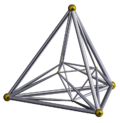Step prism

A step prism is an isogonal polychoron whose vertices swirl in correspondence to a star polygon. Similarly to how the n vertices of an {n/d} star take d turns around a circle, the n vertices of an n -d step prism take d turns around a duocylinder. The n -d step prism is a subsymmetrical faceting of an n -n duoprism.
The duals of the step prisms are called the gyrochora. These are notable, as they are isotopic. Particularly, since there's at least one non-degenerate n -d step prism for each n≥5, there exist fair four-dimensional dice with any amount of cells, starting from 5. This is in contrast to 3D, where there are no fair dice with 5 faces, for instance.
An n -d step prism has double symmetry if n is a divisor of d 2 +1 or d 2 -1. Examples include the 13-5 step prism (13 divides 52+1 = 26), 17-4 step prism (17 divides 42+1 = 17), and the 30-11 step prism (30 divides 112-1 = 120).
The convex hull of two step prisms with double symmetry can be used to construct form new isogonal polychora. For example the tetragonal-antiwedge 8-3 double step prism from two 8-3 step prisms.
Construction[edit | edit source]
To construct the n -d step prism, one starts with a n × n square grid. In 4-dimensions, one can roll the grid so that opposite edges meet. This puts the vertices on the surfaces of a flat torus, and creates in essence a n -gonal duocomb. One takes any arbitrary vertex as the starting vertex, and repeatedly moves one step to the right, and d steps up. When one reaches the starting vertex, the grid is folded into an n -n duoprism. Finally, one takes the convex hull of all the traversed vertices.
This construction only works for 2 ≤ d ≤ n–2. When d ∈ {0, 1, n–1, n}, all constructed points are coplanar, and the step prism degenerates into a regular polygon.
As a consequence of this construction, the n -d and n -(n-d) step prisms are congruent, as the latter can be constructed from the former by going d steps down instead of d steps up. Furthermore, when n and d are coprime, so that the modular inverse d –1 of d modulo n exists, the n -d –1 and n -(n-d -1 ) will also be congruent to the aforementioned step prisms, as these can be constructed by exchanging horizontal steps with vertical steps.
Skew polygons[edit | edit source]
Alternatively the step prisms can also be constructed as the convex hull of a regular skew polygon. Specifically the n -d step prism is the convex hull of {n}#{n/d}, that is the blend of {n} with {n/d}.
Vertex coordinates[edit | edit source]
Coordinates for the vertices of an n-d step prism with height ratio x are given by:
- (sin(2πk/n), cos(2πk/n), x*sin(2πdk/n), x*cos(2πdk/n)),
for k ranging from 0 to n–1.
Cells[edit | edit source]
Most often, the cells of the n -d step prism are phyllic disphenoids. More precisely, if n and d are coprime, except for the following conditions listed below, it will only contain phyllic disphenoids. However, if n and d are coprime and d 2 is equivalent to -1 mod n, then it will contain tetragonal disphenoids. If n and d are both even, or if n is even and d 2 is equivalent to 1 mod n and is a divisor of 2n, it will contain rhombic disphenoids. Finally, if n and d are not coprime, it will contain gyroprismatic cells (including those with n and d both even), such as the 8-2 step prism with rhombic disphenoids (considered as digonal gyroprisms), the 9-3 step prism with triangular gyroprisms and the 15-5 step prism with pentagonal gyroprisms.
Special cases[edit | edit source]
In four dimensions, an n-d step prism can have the least possible edge length difference by varying the height ratio (the ratio of the edge lengths of the orthogonal n-gons of an n-gonal duoprism used to create a step prism). For double symmetry cases, the ratio is 1:1. Known examples for other cases are (using the ratio method):
- 7-2: 1:√2cos(π/7) ≈ 1:1.34236
- 8-2: 1:√4+2√2/2 ≈ 1:1.30656
- 9-2: 1:√1+2cos(π/9) ≈ 1:1.69688
- 9-3: 1:√3+6cos(2π/9)/3 ≈ 1:0.91871
- 10-2: 1:(1+√5)/2 ≈ 1:1.61803
- 10-4: 1:1
- 11-2: 1:1/√2cos(π/11)-2cos(2π/11) ≈ 1:2.05638
- 11-3: 1:√(1+2sin(3π/22))/(2cos(π/11)+2sin(π/22)-1) ≈ 1:1.23333
- 12-2: 1:√2+√3 ≈ 1:1.1.93185
- 12-3: 1:√2+2√3/2 ≈ 1:1.16877
- 12-4: 1:4√27/3 ≈ 1:0.75984
- 12-5: 1:1
- 13-2: 1:1/√2cos(π/13)-2cos(2π/13) ≈ 1:2.41846
- 13-3: 1:√(cos(2π/13)+sin(3π/26))/(cos(2π/13)-sin(π/26)) ≈ 1:1.27325
- 14-2: 1:1+2cos(2π/7) ≈ 1:2.24698
- 14-3: 1:√(2cos(π/7)+2sin(π/14)-1)/(1-2sin(π/14)) ≈ 1:1.49899
- 14-4: 1:√(1+cos(2π/7))/(1+cos(π/7)) ≈ 1:0.92414
- 14-6: 1:1
- 15-2: 1:√7+3√5+√150+66√5/2 ≈ 1:2.78203
- 15-3: 1:√75+25√5+5√150+30√5/10 ≈ 1:1.43028
- 15-5: 1:√9-3√5+3√30-6√5/6 ≈ 1:0.63484
- 15-6: 1:√50+10√75-30√5/10 ≈ 1:0.88396
- 16-2: 1:√8+4√2+2√20+14√2/2 ≈ 1:2.56292
- 16-3: 1:√1+√2 ≈ 1:1.55377
- 16-4: 1:4√8+4√2/2 ≈ 1:0.96119
- 16-6: 1:√8-4√2+2√4-2√2/2 ≈ 1:1.06159
- 16-7: 1:1
- 17-2: 1:1/√2cos(π/17)-2cos(2π/17) ≈ 1:3.14656
- 17-3: 1:√(sin(7π/34)+cos(2π/17))/(cos(2π/17)-sin(5π/34)) ≈ 1:1.77592
- 17-5: 1:√(cos(3π/17)+cos(4π/17))/(cos(2π/17)+cos(3π/17)) ≈ 1:0.94418
- 18-2: 1:csc(π/18)/2 ≈ 1:2.87939
- 18-3: 1:√1+2cos(π/9) ≈ 1:1.69688
- 18-4: 1:2cos(π/18)/√3 ≈ 1:1.13716
- 18-5: 1:√cos(2π/9)sec(π/9) ≈ 0.90289
- 18-6: 1:√6cos(π/9)-3/3 ≈ 1:0.54141
- 18-8: 1:1
- 19-2: 1:1/√2cos(π/19)-2cos(2π/19) ≈ 1:3.51173
- 19-3: 1:√(sin(5π/38)+cos(2π/19))/(cos(2π/19)-sin(7π/38)) ≈ 1:1.83802
- 19-4: 1:√(cos(2π/19)+sin(π/38))/(cos(2π/19)-sin(3π/38)) ≈ 1:1.21179
- 19-7: 1:√(cos(2π/19)+cos(3π/19))/(cos(2π/19)+sin(9π/38)) ≈ 1:1.06046
- 20-2: 1:√12+4√5+2√50+22√5/2 ≈ 1:3.19623
- 20-3: 1:√2+√5 ≈ 1:2.05817
- 20-4: 1:4√625+250√5/5 ≈ 1:1.17319
- 20-5: 1:√1-√5+√10+2√5/2 ≈ 1:0.80127
- 20-6: 1:1
- 20-8: 1:4√5000-1000√5/10 ≈ 1:0.72507
- 20-9: 1:1
- n-2: 1:√(cos(2π/n)-cos(2π*floor(n/2)/n))/(cos(4π*floor(n/2)/n)-cos(4π/n))
- n-3: 1:√(cos(2π*floor((n+1)/3)/n)-cos(2π/n))/(cos(6π/n)-cos(6π*floor((n+1)/3)/n))
- 2n-(n-1): 1:1
- a*n-n: 1:√(cos(2π/n)-cos(2π/(a*n)))/(cos(2π/a)-1)
Examples[edit | edit source]
| n-d | 5-2 | 6-2 | 7-2 | 8-2 | 8-3 |
|---|---|---|---|---|---|
| Name | Pentachoron | Triangular duotegum | 7-2 step prism | 8-2 step prism | Hexadecachoron |
| Image | 
|

|

|

|

|
| n-d | 9-2 | 9-3 | 10-2 | 10-3 | 10-4 |
|---|---|---|---|---|---|
| Name | 9-2 step prism | 9-3 step prism | 10-2 step prism | Bidecachoron | Pentagonal duotegum |
| Image | 
|

|

|

|

|
Higher dimensional generalizations[edit | edit source]
Analogs of 4D step prisms exist in all even dimensions, formed in an analogous way from higher multiprisms. For example, a 6D n -m -k step prism would be formed as the convex hull of {n}#{n/m}#{n/k}, or by faceting of the n -gonal trioprism, where we start with a 3D grid of cubes and move 1 step in one direction, m steps in another, and k steps in the third direction.
Additionally the step prisms can be generalized to include the convex hulls of blends of higher rank polytopes (i.e. not polygons). The simplest example is the 6D icosahedral-great icosahedral step prism, which is the hull of the skew icosahedron. Since the dimension of the blend (6) is half the number of vertices in the components (12), the skew icosahedron is an orthoplex realization and its convex hull is the 6-orthoplex.
External links[edit | edit source]
- Bowers, Jonathan. "Four Dimensional Dice Up To Twenty Sides".